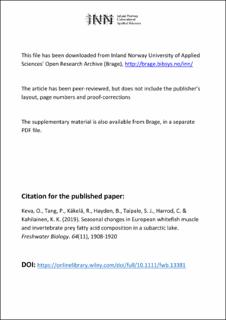Seasonal changes in European whitefish muscle and invertebrate prey fatty acid composition in a subarctic lake
Keva, Ossi; Tang, Patrik; Käkelä, Reijo; Hayden, Brian; Taipale, Sami J.; Harrod, Chris; Kahilainen, Kimmo Kalevi
Peer reviewed, Journal article
Accepted version
Permanent lenke
https://hdl.handle.net/11250/2679505Utgivelsesdato
2019Metadata
Vis full innførselSamlinger
Sammendrag
Ambient light and temperature show extreme seasonal variation in subarctic lakes due to the midnight sun period in summer and cold polar night period in winter. These changes have clear impacts on fish feeding and reproduction cycles, potentially affecting the fatty acid (FA) composition of muscle. Despite extensive research into fish FA over recent decades, we know little about intra‐annual changes of fish FA profile and content.
We studied intra‐annual changes in the FA profile (mol%) and content (mg g‐1 dry weight) of sexually mature European whitefish (Coregonus lavaretus) muscle in a large and deep subarctic lake located in northern Fennoscandia. We collected fish, zooplankton, and benthic macroinvertebrate samples during 3 ice‐covered months, including December (during whitefish spawning), and 3 open‐water months. Fish size, age, sex, stomach content and fullness, and gonadosomatic index were also assessed as co-variates.
Whitefish changed diet from benthic macroinvertebrates in winter to zooplankton in summer. Generally, whitefish somatic growth was slow and most energy was used for gonad growth. Zooplankton had higher total content and different profile of FA compared to benthic macroinvertebrates. Increased zooplanktivory in summer was detected with higher α‐linolenic acid (ALA, 18:3n‐3) and stearidonic acid (SDA, 18:4n‐3) percentage and content as well as increased the ratio of polyunsaturated FAs (PUFAs) of n‐3 and n‐6 family (n‐3/n‐6 ratio) in fish muscle.
Whitefish gonadal growth and development occur during the summer growing season and continue until the initiation of spawning in early winter. We found that the content of physiologically crucial PUFA, eicosapentaenoic acid (EPA, 20:5n‐3), docosahexaenoic acid (DHA, 22:6n‐3), and arachidonic acid (ARA, 20:4n‐6) decreased by c. 60% between late summer and the spawning period in early winter. After spawning, total FA content of whitefish muscle increased rapidly, reaching the maximum recorded level in mid‐summer.
Intra‐annual changes in whitefish muscle FA profiles and contents were modified both by available diet and reproductive phase; however, reproductive physiology was clearly a stronger driver of the changes in muscle FA composition. Results suggest marked changes in intra‐annual FA composition of fish muscle, an important factor that should be considered in future studies and especially in long term monitoring programs. Future studies are needed to determine whether these inter‐annual FA patterns revealed in this study can be extended to different regions and to e.g. adipose or spring spawning species.
